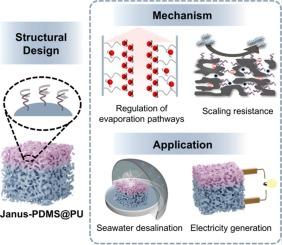Hierarchical Janus sponge evaporator functionalized with liquid-like PDMS molecular brushes for efficient and sustainable solar evaporation and electricity generation
IF 13.2
1区 工程技术
Q1 ENGINEERING, CHEMICAL
引用次数: 0
Abstract
To address the global challenges of freshwater scarcity and the growing demand for clean energy, we report a Janus-structured system based on a polyurethane (PU) sponge scaffold for efficient solar-driven desalination and electricity generation. Through sponge modification, polydimethylsiloxane (PDMS) molecular brushes were integrated with a Janus structure to construct an asymmetric interface featuring a distinct wettability contrast. This design facilitated directional water transport and efficient steam escape pathways, while effectively suppressing contaminant adsorption and pore blockage. Consequently, the device exhibited enhanced solar energy conversion efficiency and effectively achieved simultaneous seawater desalination and electricity generation. Meanwhile, Conductivity measurements confirmed that the ion concentration in the collected freshwater remained consistently low, with Na+ levels at 12.9 mg·L−1 and K+ levels at 2.2 mg·L−1, both significantly below the World Health Organization (WHO) standards. In addition to desalination, the system also generated an open-circuit voltage of up to 0.5 V, and achieved a maximum evaporation rate of 4.86 kg m−2 h−1. Long-term stability tests indicated a performance retention exceeding 90 %. These results highlight the significant potential of the fabricated evaporator for sustainable seawater desalination and energy co-generation.

分层Janus海绵蒸发器功能与液体状PDMS分子刷,高效和可持续的太阳能蒸发和发电
为了应对淡水短缺和清洁能源需求不断增长的全球挑战,我们报告了一种基于聚氨酯(PU)海绵支架的janus结构系统,用于高效的太阳能驱动海水淡化和发电。通过海绵改性,将聚二甲基硅氧烷(PDMS)分子刷与Janus结构结合,构建了具有明显润湿性对比的不对称界面。这种设计促进了定向水输送和有效的蒸汽逸出通道,同时有效地抑制了污染物吸附和孔隙堵塞。因此,该装置提高了太阳能转换效率,有效地实现了海水淡化和发电的同时进行。同时,电导率测量证实,收集的淡水中的离子浓度一直很低,Na+水平为12.9 mg·L−1,K+水平为2.2 mg·L−1,均显著低于世界卫生组织(WHO)的标准。除脱盐外,该系统还产生了高达0.5 V的开路电压,并实现了4.86 kg m−2 h−1的最大蒸发速率。长期稳定性测试表明,性能保持率超过90% %。这些结果突出了制造蒸发器在可持续海水淡化和能源热电联产方面的巨大潜力。
本文章由计算机程序翻译,如有差异,请以英文原文为准。
求助全文
约1分钟内获得全文
求助全文
来源期刊

Chemical Engineering Journal
工程技术-工程:化工
CiteScore
21.70
自引率
9.30%
发文量
6781
审稿时长
2.4 months
期刊介绍:
The Chemical Engineering Journal is an international research journal that invites contributions of original and novel fundamental research. It aims to provide an international platform for presenting original fundamental research, interpretative reviews, and discussions on new developments in chemical engineering. The journal welcomes papers that describe novel theory and its practical application, as well as those that demonstrate the transfer of techniques from other disciplines. It also welcomes reports on carefully conducted experimental work that is soundly interpreted. The main focus of the journal is on original and rigorous research results that have broad significance. The Catalysis section within the Chemical Engineering Journal focuses specifically on Experimental and Theoretical studies in the fields of heterogeneous catalysis, molecular catalysis, and biocatalysis. These studies have industrial impact on various sectors such as chemicals, energy, materials, foods, healthcare, and environmental protection.
 求助内容:
求助内容: 应助结果提醒方式:
应助结果提醒方式:


